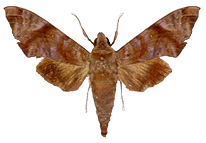|
Acosmeryx shervillii Boisduval sp. rev.
Acosmeryx shervillii Boisduval, 1875, Hist. nat. Insectes, Spec, Gen. Lep.,
1: 217.
Acosmeryx cinerea Butler, 1875, Proc. zool. Soc. Lond., 1875: 245.
Acosmeryx pseudonaga Butler, 1881, Illustr. typ. Specimens Lep. Het. B. M., 5: 2.
Acosmeryx miskini brooksi Clark, 1922, Proc. New Engl. Zool. Club, 8: 11.
|

Acosmeryx shervillii ♂
(pseudonaga)
(.65
natural size)
|

Acosmeryx shervillii ♂
(typical)
(.65
natural size) |
Diagnosis. See Acosmeryx anceus
Stoll, and taxonomic notes below.
Taxonomic notes. This species is that referred to under A. socrates
Boisduval by recent authors (e.g. Diehl, 1980; D'Abrera, 1986).
Boisduval's types are in the Carnegie Museum, Pittsburg, but it has been
possible to examine colour photographs of all the Acosmeryx. Typical
socrates was described from the Philippines and also occurs in
Sulawesi.
It is intermediate in appearance between the two forms or species occuring
in the rest of the Oriental Region. Both occur in Borneo and are
illustrated here. Their geographical range is coincident, yet there are
significant, constant differences in facies that led Kernbach (1967) and
Diehl (1980) to treat them as distinct species.
One form is strikingly contrasted on the forewings and has a strong yellow
discal spot, resembling a large but less red anceus (see also the
description of hindwing differences in the diagnosis of anceus). The name
pseudonaga Butler is applicable.
The
second form is typical shervillii, paler; greyer, with more
crenulate, definite but finer forewing fasciae. The discal spot is
smaller, with only a weak yellow centre. At the forewing margin the dark
triangular zone posterior to the apical excavation is much narrower. The
names cinerea Butler and brooksi Clark refer to this typical
form.
The male genitalia offer no reliable distinction between the two forms,
though there is variation in the shape and degree of spining of the harpe.
Typical socrates from the Philippines and Sulawesi has the harpe
smaller but deeper, more plate-like and less heavily spined than in more
westerly populations. A. miskini Murray from New Guinea has the
harpe slightly more elongate and irregular than in pseudonaga/shervillii.
In all members of the complex the shape of the harpe is more irregular
than in other Acosmeryx.
It is thus clear that Oriental populations from Sundaland westwards
belong to a taxon or taxa distinct from typical socrates, for which
the oldest name is shervillii, with the two forms referable to shervillii
(=
f. obliqua Dupont) and pseudonaga ( = f. cinerea sensu
Dupont and f. obscura Dupont). The name shervillii has page
priority over socrates; the latter name must be restricted to the
Philippines and Sulawesi taxon.
Both forms were noted as larvae from the same host-plant at the same time
by Dupont & Roepke (1941). It is therefore likely, considering this
and the total geographical coincidence of the two forms, that they belong
to a single, dimorphic species. This could be tested further by
electrophoretic studies or breeding experiments. In Borneo f. shervillii
is in the ratio of 1:4 with f. pseudonaga. There is no
ecological segregation evident.
Geographical range. Indian Subregion to Sundaland; Philippines,
Sulawesi.
Habitat preference. This is probably a general lowland species but
was taken as high as 2600m on G. Kinabalu (Holloway, 1976).
Biology. The larva was described and illustrated by Dupont &
Roepke (1941). The young larva is green, spotted pale green, a
dorsolateral band pale green over the anterior half, white posteriorly;
abdominal segments have a brown dorsal patch. The horn is granulate,
brownish black, upcurved. The full grown larva is green with pale brown
dorsal patches. The thorax is swollen over Al. The white
dorsolateral line runs from A3 backwards, with a series of oblique yellow
bars below it; a detached section runs obliquely over Al and A2. The horn
is shorter, green, downcurved. In India (Bell & Scott, 1937) the
dorsolateral line and thoracic flange are associated with reddish or plum
colour, and the dorsal spots are of the latter shade. The larva
illustrated by Semper (1896-1902) for typical socrates is also
comparable.
Recorded host-plants (Bell & Scott, 1937; Dupont & Roepke,
1941; Barlow, 1982) are: Saurauia (Actinidaceae); Dillenia (Dilleniaceae);
Leea (Leeaceae); Cayratia, Cissus, Vitis (Vitidaceae).
<<Back
>>Forward <<Return
to Contents page
|

